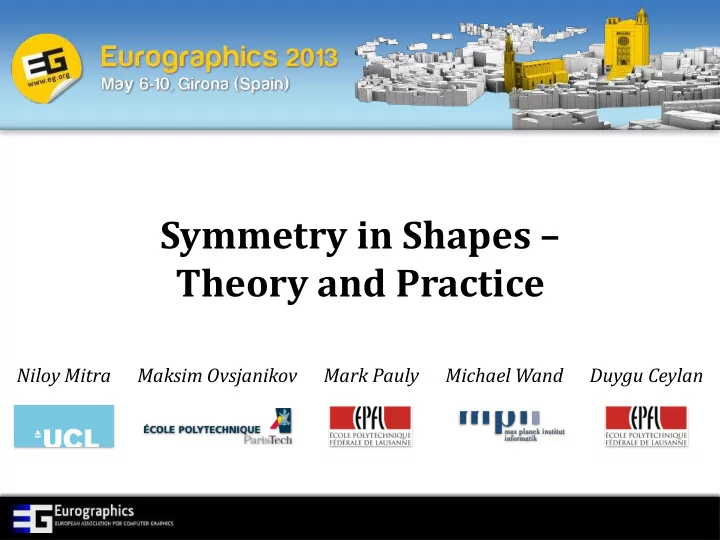

Symmetry in Shapes – Theory and Practice Niloy Mitra Maksim Ovsjanikov Mark Pauly Michael Wand Duygu Ceylan
Symmetry in Shapes – Theory and Practice Representations & Applications Michael Wand Saarland University / MPI Informatik
Representations & Applications
Toy Example How many building blocks are these?
Toy Example How many building blocks are these?
What is Symmetry? Set of operations 𝑔 that leave object 𝑌 intact • 𝑔 𝑌 = 𝑌 Operations 𝐻 = 𝑔 𝑔 𝑌 = 𝑌 form a group 𝐻 encodes absent information
Derived Properties Pairwise Correspondences Pairwise matches T
Derived Properties Pairwise Correspondences Pairwise matches T Permutation Groups Exchangeable building blocks
Derived Properties Pairwise Correspondences Pairwise matches T Permutation Groups Exchangeable building blocks Transformation Groups Regular transformations T T T T 𝐔 𝑗 |𝑗 ∈ ℤ
Pairwise Matches T
Input Data (Point Cloud) [data set: C. Brenner, IKG Univ. Hannover]
Feature Representation [data set: C. Brenner, IKG Univ. Hannover]
[data set: C. Brenner, IKG Univ. Hannover]
Result [data set: C. Brenner, IKG Univ. Hannover]
Symmetry Detection Partial Symmetry Detection • Yields pairwise partial correspondences • No symmetry groups (yet)
Applications Pairwise correspondences • Non-local denoising • Symmetrization • Constrained editing Techniques • Correspondences transport information • Simplification of pairwise relations • Pairwise constraints as invariants
Non-Local Denoising data MLS non-local [Gal et al. 2007]
Non-Local Denoising MLS non-local 16 parts [Bokeloh et al. 2009] [data set: C. Brenner, University Hannover]
Non-Local Denoising data non-local denoising [Zheng et al. 2010]
Symmetrization [Mitra et al. 2007]
Symmetry Preserving Editing
iWires [Gal et al. 2009] Symmetry-based propagation of edits: additional references [Wang et al. 2011], [Zheng et al. 2011]
Permutation & Building Blocks
Example Scene
Pairwise Correspondences
Cutting at the Boundaries
Microtiles
3D Result
Properties General framework • Need point-wise equivalent relations Canonical, unique decomposition Every point of every piece is unique • Microtiles cannot have partial correspondences Microtiles reveal permutation groups
Symmetry Factored Embedding [Lipman et al. 2010] Related Concept • Points that map together in once piece • Consistent orbits • Ignores transformation, point-wise orbits
Inverse Procedural Modeling Rules from example geometry • Example model • Compute rules describing a class of similar models Output Input
Inverse Procedural Modeling r-Similarity • Local neighborhoods match exemplar radius r radius r radius r output input
Inverse Procedural Modeling [data set: G. Wolf]
Theoretical Results All 𝑠 -similar objects are made out of (𝑠 − 𝜗) -microtiles • Unique construction • Connectivity same as in the example Implications • Canonical representation • Synthesis = solving jigsaw puzzles
Shape Grammar
Practice: Context Free Grammar b 1 Grammar: b 2 A a 1 B C | a 2 D a 1 b 3 B b 1 | b 2 | b 3 B C c 1 | c 2 c 1 D d 1 | d 2 C c 2 A d 1 a 2 D d 2
[data sets: G. Wolf, Dosch 3D] Practical Results
Fast Pairwise Matches T
Quadratic Complexity? [data set: C. Brenner, IKG Univ. Hannover]
Cliques / Equivalence Classes
Scalable Symmetry Detection [data set: C. Brenner, IKG Univ. Hannover] Hannover scans: 128M points / 14GB detection: 23 min preproc.: 43 min [Kerber et al. 2013] [data set: C. Brenner, IKG Univ. Hannover]
Regular Transformations
Applications Symmetry: regularity (transformations) • Inverse procedural modeling • Regularity preserving editing • Shape recognition • Shape understanding Techniques • Transformation groups characterize shapes • Transformation group structure as invariants
Inverse Procedural Modeling [Mitra et al. 2008] [Pauly et al. 2008]
Regularity Aware Deformation [Bokeloh et al. 2011]
Algebraic Shape Editing [Bokeloh et al. 2012]
Shape Recognition [Kazhdan et al. 2004] [Podolak et al. 2006] [Thrun et al. 2005]
Shape Understanding [Mehra et al. 2009] [Mitra et al. 2010]
Conclusions
Symmetry Principle • Absence of information • Invariance under operations Structure • Global Symmetry: transformation groups • Partial Symmetry: permutations of building blocks Detection • Pairwise matching (efficient pruning, segmentation) • Regular transformations: estimate generators • Intrinsic formulations
Applications Different structural insights • Correspondence Equivalence Pairwise relations • Permutations Building blocks Shape grammar Hierarchical encoding • Regularity Structural invariant Regularity relations Different Applications
Open Problems
Open Problems Future Work & Open Problems • Detection Scalability Partial intrinsic symmetry detection Approximate (deformable) symmetry • Modeling More general, semantic symmetry Equivalence of chairs, cars, houses? Avoid overfitting? • Theoretical framework Approximate group theory?
Recommend
More recommend